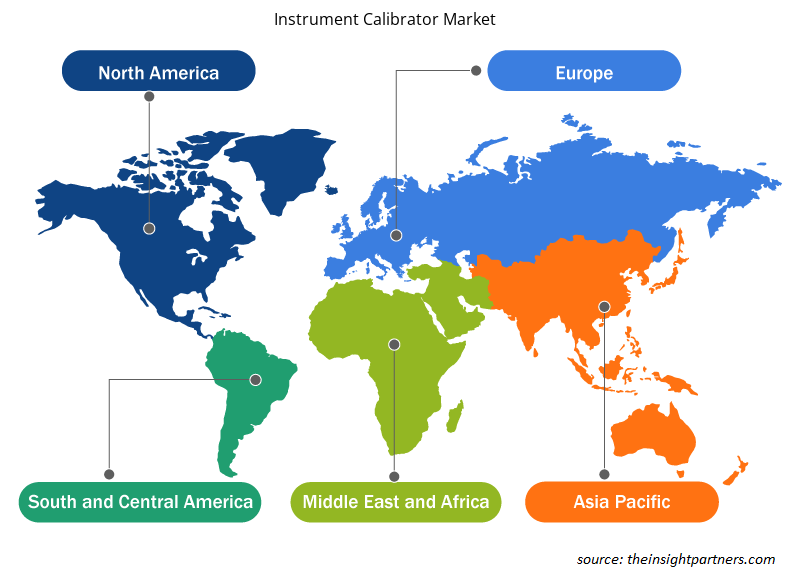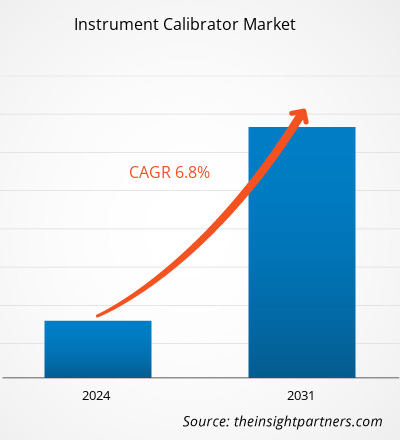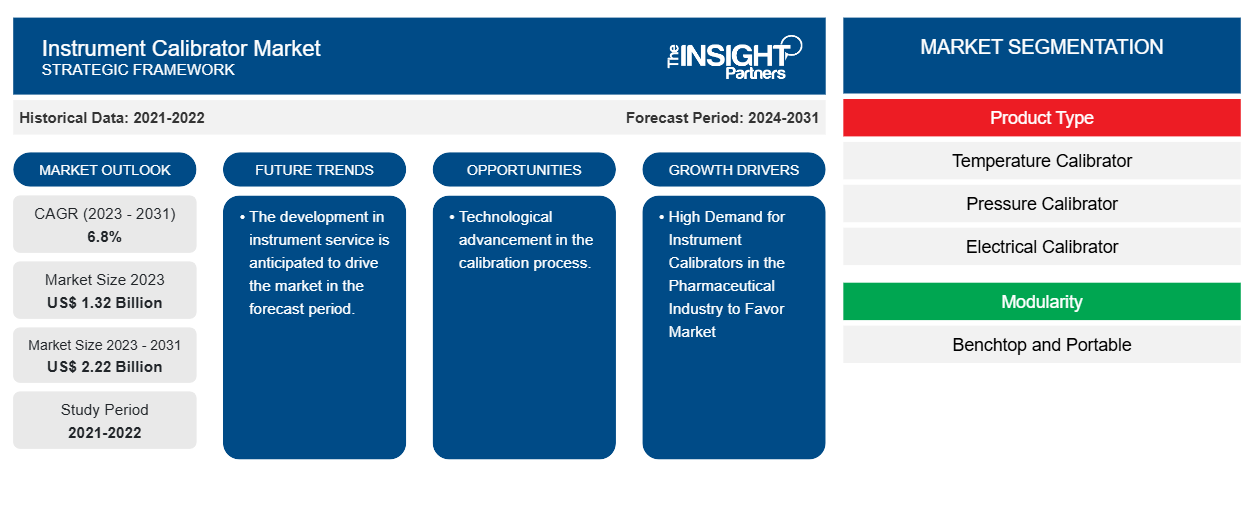Der Markt für Instrumentenkalibratoren soll von 1,32 Milliarden US-Dollar im Jahr 2023 auf 2,22 Milliarden US-Dollar im Jahr 2031 anwachsen. Der Markt wird zwischen 2023 und 2031 voraussichtlich eine durchschnittliche jährliche Wachstumsrate von 6,8 % verzeichnen. Die steigende Nachfrage aus der Pharmaindustrie sowie der technologische Fortschritt und die Erschwinglichkeit von Kalibratoren dürften weiterhin die wichtigsten Trends und Treiber des Marktes bleiben.
Marktanalyse für Instrumentenkalibratoren
Die Nachfrage nach Instrumentenkalibratoren dürfte wachsen, da die steigende Nachfrage aus der Pharma-, Luftfahrt- und Verteidigungsindustrie den Instrumentenkalibratormarkt antreibt. Darüber hinaus wird erwartet, dass verschiedene staatliche Vorschriften, technologische Fortschritte und Instrumentenkalibrierungen den Markt in den kommenden Jahren antreiben werden.
Marktübersicht für Instrumentenkalibratoren
Die Instrumentenkalibrierung ist ein wichtiger Bestandteil jedes Messsystems. Sie stellt sicher, dass die Instrumente ordnungsgemäß funktionieren und präzise Messwerte liefern. Dabei werden die Messwerte eines Instruments mit denen eines Referenzinstruments oder Kalibrators verglichen. Die Kalibrierung trägt dazu bei, Zuverlässigkeit, Genauigkeit, Sicherheit und die Einhaltung von Industriestandards sicherzustellen.
Passen Sie diesen Bericht Ihren Anforderungen an
Sie erhalten kostenlos individuelle Anpassungen an jedem Bericht, einschließlich Teilen dieses Berichts oder einer Analyse auf Länderebene, eines Excel-Datenpakets sowie tolle Angebote und Rabatte für Start-ups und Universitäten.
- Holen Sie sich die wichtigsten Markttrends aus diesem Bericht.Dieses KOSTENLOSE Beispiel umfasst eine Datenanalyse von Markttrends bis hin zu Schätzungen und Prognosen.
Treiber und Chancen auf dem Markt für Instrumentenkalibratoren.
Hohe Nachfrage nach Instrumentenkalibratoren in der Pharmaindustrie begünstigt den Markt
Die Instrumentenkalibrierung ist eine wichtige GMP- Aktivität in der Pharmaindustrie. Sie gewährleistet genaue Messungen wichtiger Instrumente und trägt zur Aufrechterhaltung der Produktqualität und -sicherheit bei. Bei diesem Prozess werden Instrumente mit bekannten Standards verglichen, um die Genauigkeit innerhalb festgelegter Toleranzen zu überprüfen. Pharmazeutische Anlagen können ohne Kalibrierung funktionieren. Die Einhaltung der strengen EMEA- /FDA-Vorschriften und ISO-Standards, ganz zu schweigen von der enormen Menge an Instrumenten, die regelmäßig kalibriert werden müssen, kann jedoch ein kostspieliger und zeitaufwändiger Prozess sein. Es werden große Mengen an Kalibrierungsdaten erstellt und archiviert, die insbesondere im Falle eines Audits bequem zugänglich sein müssen. Dies schafft eine enorme Nachfrage nach Instrumentenkalibrierung, was das Marktwachstum weiter ankurbelt.
Technologischer Fortschritt im Kalibrierungsprozess.
Technologische Fortschritte im Kalibrierungsprozess bergen enorme Chancen. Die Nachfrage nach automatisierter Software zur Verbesserung der Prozessgenauigkeit und -effizienz steigt. Mithilfe von Software zur Kalibrierungsautomatisierung können manuelle Prozesse und Verfahren in Aufgaben mit geringem oder sogar keinem Eingriff umgewandelt werden. Auch künstliche Intelligenz für Deep Learning und intelligente Kalibrierung gewinnt an Bedeutung. Täglich werden neue Anwendungen für diese Tools entdeckt, und die Kalibrierung ist einer der vielen Sektoren, die von diesem Technologieboom profitieren . Aufgrund der oben genannten Parameter wird erwartet, dass der technologische Fortschritt im Kalibrierungsprozess das Marktwachstum in den kommenden Jahren ankurbeln wird.
Marktbericht zu Instrumentenkalibratoren – Segmentierungsanalyse
Wichtige Segmente, die zur Ableitung der Marktanalyse für Instrumentenkalibratoren beigetragen haben, sind Produkttyp, Modularität und Branche.
- Basierend auf dem Produkttyp ist der Markt für Instrumentenkalibratoren in Temperaturkalibratoren , Druckkalibratoren, elektrische Kalibratoren und Multifunktionsprozesskalibratoren unterteilt. Das Segment der Temperaturkalibratoren dürfte im Prognosezeitraum einen erheblichen Anteil halten.
- Der Markt für Instrumentenkalibratoren basiert auf Modularität und ist sowohl als Tisch- als auch als tragbares Gerät erhältlich. Das tragbare Segment dürfte im Prognosezeitraum einen erheblichen Anteil halten.
- Nach Branchen ist der Markt in die Branchen Automobil, Luft- und Raumfahrt und Verteidigung, Elektronik, Lebensmittel und Getränke, Pharmazie, Öl und Gas sowie andere unterteilt. Das Automobilsegment dürfte im Prognosezeitraum einen erheblichen Marktanteil halten.
Marktanteilsanalyse für Instrumentenkalibratoren nach Geografie
Der geografische Umfang des Marktberichts zum Instrumentenkalibrator ist hauptsächlich in fünf Regionen unterteilt: Nordamerika, Asien-Pazifik, Europa, Naher Osten und Afrika sowie Süd- und Mittelamerika.
Nordamerika dominiert den Markt. Nordamerika umfasst Länder wie die USA, Kanada und Mexiko. Die Region verzeichnet ein beträchtliches Wachstum aufgrund von Faktoren wie der Verfügbarkeit von Tisch- und tragbaren Instrumentenkalibratoren in Industrie- und Entwicklungsländern. Darüber hinaus erhöht die hohe Nutzung tragbarer Kalibratoren aufgrund ihrer benutzerfreundlichen Oberfläche und erschwinglichen Preise ihre weltweite Nachfrage. Darüber hinaus steigert der Fokus auf Forschung und Entwicklung den technologischen Fortschritt in der Region. Außerdem gibt es in der Region eine große Anzahl wichtiger Hersteller auf dem Markt. Aufgrund all dieser Parameter gewinnt der Markt in Nordamerika an Zugkraft.
Regionale Einblicke in den Instrumentenkalibratormarkt
Die regionalen Trends und Faktoren, die den Markt für Instrumentenkalibratoren im Prognosezeitraum beeinflussen, wurden von den Analysten von Insight Partners ausführlich erläutert. In diesem Abschnitt werden auch die Marktsegmente und die Geografie von Instrumentenkalibratoren in Nordamerika, Europa, im asiatisch-pazifischen Raum, im Nahen Osten und Afrika sowie in Süd- und Mittelamerika erörtert.

- Erhalten Sie regionale Daten zum Markt für Instrumentenkalibratoren
Umfang des Marktberichts zu Instrumentenkalibratoren
| Berichtsattribut | Details |
|---|---|
| Marktgröße im Jahr 2023 | 1,32 Milliarden US-Dollar |
| Marktgröße bis 2031 | 2,22 Milliarden US-Dollar |
| Globale CAGR (2023 - 2031) | 6,8 % |
| Historische Daten | 2021-2022 |
| Prognosezeitraum | 2024–2031 |
| Abgedeckte Segmente | Nach Produkttyp
|
| Abgedeckte Regionen und Länder | Nordamerika
|
| Marktführer und wichtige Unternehmensprofile |
|
Marktteilnehmerdichte: Der Einfluss auf die Geschäftsdynamik
Der Markt für Instrumentenkalibratoren wächst rasant, angetrieben durch die steigende Nachfrage der Endnutzer aufgrund von Faktoren wie sich entwickelnden Verbraucherpräferenzen, technologischen Fortschritten und einem größeren Bewusstsein für die Vorteile des Produkts. Mit steigender Nachfrage erweitern Unternehmen ihr Angebot, entwickeln Innovationen, um die Bedürfnisse der Verbraucher zu erfüllen, und nutzen neue Trends, was das Marktwachstum weiter ankurbelt.
Die Marktteilnehmerdichte bezieht sich auf die Verteilung von Firmen oder Unternehmen, die in einem bestimmten Markt oder einer bestimmten Branche tätig sind. Sie gibt an, wie viele Wettbewerber (Marktteilnehmer) in einem bestimmten Marktraum im Verhältnis zu seiner Größe oder seinem gesamten Marktwert präsent sind.
Die wichtigsten auf dem Markt für Instrumentenkalibratoren tätigen Unternehmen sind:
- AMETEK Inc.
- Baker Hughes Unternehmen
- Extech-Instrumente
- Fluke Corporation
- Yokogawa Electric Corporation
- WIKAAlexander Wiegand SE & co. KG
Haftungsausschluss : Die oben aufgeführten Unternehmen sind nicht in einer bestimmten Reihenfolge aufgeführt.

- Überblick über die wichtigsten Akteure auf dem Markt für Instrumentenkalibrierung
Neuigkeiten und aktuelle Entwicklungen zum Markt für Instrumentenkalibratoren
Der Markt für Instrumentenkalibratoren wird durch die Erhebung qualitativer und quantitativer Daten nach Primär- und Sekundärforschung bewertet, die wichtige Unternehmensveröffentlichungen, Verbandsdaten und Datenbanken umfasst. Nachfolgend sind einige der Entwicklungen auf dem Markt für Instrumentenkalibratoren aufgeführt:
- ABB hat mit dem Bau einer neuen 12.000 Quadratmeter großen Kalibrierhalle im Industriepark neben seiner bestehenden 200.000 Quadratmeter großen Produktionsstätte in Bartlesville, Oklahoma, begonnen. Die Investition wird die Kalibrierungskapazitäten des Unternehmens stärken und den Kunden ein hohes Maß an Qualität und Genauigkeit in der gesamten Durchflussmesserpalette von ABB bieten. Darüber hinaus wird das Angebot des Unternehmens „Made in America“ weiter ausgebaut. (Quelle: ABB-Unternehmenswebsite, Januar 2024)
- Dracal Technologies gab die Unterzeichnung einer Vereinbarung zwischen Dracal Technologies und Essco Calibration Laboratory in den USA bekannt. Essco ist ein nach ISO/IEC 17025:2017 akkreditiertes Labor mit über 50 Jahren Erfahrung in der Kalibrierung von Messgeräten. (Quelle: Dracal Technologies, Unternehmenswebsite, November 2023)
Marktbericht zu Instrumentenkalibratoren – Umfang und Ergebnisse
Der Bericht „Marktgröße und Prognose für Instrumentenkalibratoren (2021–2031)“ bietet eine detaillierte Analyse des Marktes, die die folgenden Bereiche abdeckt:
- Marktgröße und Prognose für Instrumentenkalibratoren auf globaler, regionaler und Länderebene für alle abgedeckten wichtigen Marktsegmente.
- Markttrends für Instrumentenkalibratoren sowie Marktdynamik wie treibende Faktoren, Hemmnisse und wichtige Chancen.
- Detaillierte PEST/Porters Five Forces- und SWOT-Analyse.
- Marktanalyse für Instrumentenkalibratoren, die wichtige Markttrends, globale und regionale Rahmenbedingungen, wichtige Akteure, Vorschriften und aktuelle Marktentwicklungen abdeckt.
- Branchenlandschaft und Wettbewerbsanalyse, einschließlich Marktkonzentration, Heatmap-Analyse, prominenten Akteuren und aktuellen Entwicklungen auf dem Markt für Instrumentenkalibratoren.
- Detaillierte Firmenprofile.
- Historische Analyse (2 Jahre), Basisjahr, Prognose (7 Jahre) mit CAGR
- PEST- und SWOT-Analyse
- Marktgröße Wert/Volumen – Global, Regional, Land
- Branchen- und Wettbewerbslandschaft
- Excel-Datensatz
Aktuelle Berichte
Erfahrungsberichte
Grund zum Kauf
- Fundierte Entscheidungsfindung
- Marktdynamik verstehen
- Wettbewerbsanalyse
- Kundeneinblicke
- Marktprognosen
- Risikominimierung
- Strategische Planung
- Investitionsbegründung
- Identifizierung neuer Märkte
- Verbesserung von Marketingstrategien
- Steigerung der Betriebseffizienz
- Anpassung an regulatorische Trends





















 Kostenlose Probe anfordern für - Markt für Instrumentenkalibratoren
Kostenlose Probe anfordern für - Markt für Instrumentenkalibratoren